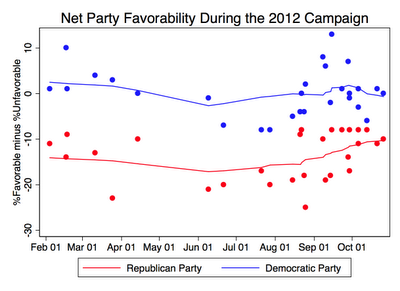Everything you need to know to understand why Obama won, in one image

President Obama won re-election yesterday, and the pundits are all falling over each other to explain the hows and whys. But I would suggest that the answer is pretty simple. So simple, in fact, that it can be summed up in a single image.
That’s the image over there on the right. It comes from an October 31 post on the blog of Tom Holbrook, a political science professor at the University of Wisconsin at Milwaukee. The lines show the trends this year in how people feel about the two major parties in the United States — their “favorability.” Each point is a poll, and its position along the vertical axis is determined by the percentage of people in that poll said they felt favorably about that party, minus the percentage who said they felt unfavorably about it.
What’s notable here are two things:
- The Democratic Party line consistently hovers around zero;
- The Republican Party line ranges from -15 to -10.
What this means is that throughout 2012, there wasn’t a whole lot of enthusiasm for the Democratic Party — the percentages of people who said they liked Democrats generally were more or less canceled out by those who said they didn’t like them. There was, however, a fair bit of negative enthusiasm for the Republican Party, with 10-15% more respondents saying they disliked Republicans than liked them.
This single observation explains a lot. In theory, Obama should have had a harder time than he ended up actually having last night: he’s an incumbent President presiding over a stagnant economy, and enthusiasm among his base started out weak, while his opponents had been energized by the fights against his health reform and economic plans. An opposition Congress had denied him major achievements, and he’d accepted watered-down versions of those he did get passed in futile attempts to woo them. In the first debate he seemed tired, and his performances in the second and third debates, while better, weren’t clear knockouts either.
But all of that turned out to matter less than it might have, because his opponent, Mitt Romney, was weighed down by an even greater burden: the burden of having an R next to his name.
Voters, it turns out, aren’t stupid. When things happen, they remember. So when Romney tried to capitalize on the weak economy by blaming it on Obama’s policies, they were smart enough to remember that George W. Bush, not Obama, was President when the economy went into the tank. They weren’t happy with the slow pace of recovery — a point this blog predicted would be a drag on Obama’s support two years ago — but they figured a slow recovery was better than a crash back into depression, which is the image that little R conjures up now. This is the boat anchor that Bush shackled onto the leg of the Republican Party, and they haven’t figured out a way to wriggle out of it yet.
That is a major, major problem for Republicans as a party. They simply cannot compete at the national level if their “brand” has become so tainted that any candidate who carries it takes a 10% hit in public opinion just for doing so. In a country as narrowly divided as this one is, that’s electoral suicide.
There’s two ways a political party can overcome a handicap like this. The first is time: wait long enough, and people will eventually forget the disasters that prompted their negative reaction in the first place. But that’s a very slow process; it can take decades. The second is a major, visible change in direction: breaking with at least some the candidates and policy positions that the party is currently associated with, and providing a clear, striking new definition of what belonging to that party means. But Mitt Romney was never that kind of candidate — and if he had been, it’s not clear that he’d have had any chance at all of surviving the Republican primaries, in which the only thing that counts is how slavishly the candidate can parrot conservative shibboleths.
This is the long-term challenge the Republicans are going to have to face, either now or sometime in the future: figuring out a way for candidates to run as a Republican without having to fit in the mold of George W. Bush. Because it’s pretty clear that American voters don’t find the products that come out of that mold appealing anymore.
